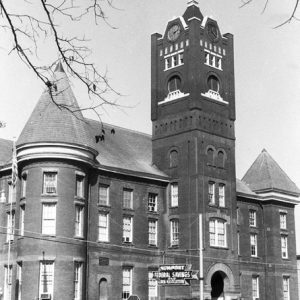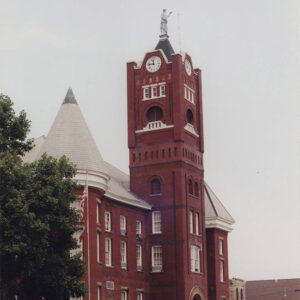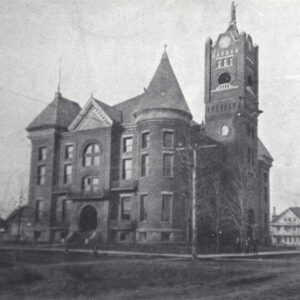calsfoundation@cals.org
Jackson County Courthouse
The Jackson County Courthouse, built in 1892, is located on 208 Main Street in downtown Newport (Jackson County). The Arkansas Historic Preservation Program recognizes the three-story building as architecturally and historically significant as a fine example of a preserved Victorian-era building in the county and as one of the oldest courthouses in the state. It was added to the National Register of Historic Places on November 18, 1976.
When construction of the Cairo and Fulton Railroad came through in 1873, the previously impoverished river town of Newport found itself in an economic boom, with a new flow of people and commerce arriving from across the country. The railroad also replaced the river as the way to move goods and people. Steamboats that regularly passed through the county seat of Jacksonport (Jackson County) ceased, and the economic and population nucleus of Jackson County shifted to Newport. Voters attempted to move the government center down the White River to Newport, recognizing its growing importance, but efforts fell short. Elections in 1882 and 1886—both presidential election years—resulted in the decision to keep the county seat in Jacksonport. The main reason for resistance was the relatively recent construction of a courthouse in Jacksonport in 1872. Today, that courthouse serves as a museum at Jacksonport State Park. During a non-presidential election year in 1891, voters selected Newport as the new county seat by an overwhelming margin.
The architect of the red brick courthouse in Newport is unknown, but the courthouse was similar to the Ouachita County Courthouse at the time in Camden (Ouachita County). The Jackson County Courthouse was completed in 1892 and cost $44,196.
The most distinguishing feature is the clock tower placed above the principal façade. However, a windstorm damaged the original in 1902. Construction on a new clock tower was completed in 1903, and the “Hour Strike Tower Clock” was installed the following year. Lady Justice, a common figure in judicial sectors of government, is placed atop the tower. Other exterior features include a rusticated-stone foundation, massive building stones, and columns that give the building a Romanesque appearance. Other towers are included in the building, with hipped and conical roofs topping the building, complementing the Victorian style.
The courthouse truly stands at the center of county government, with various divisions filling up its three floors. The first floor includes the county clerk’s office, judge’s office, and tax collector’s office. The second floor includes the state revenue office, the motor vehicles office, the prosecuting attorney’s office, a witness room, a jury room, and the courtroom. Many original features make up the courtroom, including a wheeled attorney lectern, paneled woodwork in the jury box and witness stand, wainscoting, and oak doors. The clerks’ seals rest at the courtroom desk, which is uncommon. The third floor includes veterans’ services and the voter registration office.
Notable updates include a voter-approved motion in 1939 to build an annex; it houses county health services. Also, walls have been renovated, with the old plaster updated with sheetrock, and the original tile floors have been replaced.
For additional information:
Gill, John Purifoy, and Marjem Jackson Gill. On the Courthouse Square in Arkansas. N.p.: 1980.
“Jackson County Courthouse.” National Register of Historic Places nomination form. On file at Arkansas Historic Preservation Program, Little Rock, Arkansas. Online at http://www.arkansaspreservation.com/National-Register-Listings/PDF/JA0189.nr.pdf (accessed November 12, 2020).
Jared Craig
Arkansas Historic Preservation Program
 Historic Preservation
Historic Preservation Post-Reconstruction through the Gilded Age, 1875 through 1900
Post-Reconstruction through the Gilded Age, 1875 through 1900 Jackson County Courthouse
Jackson County Courthouse  Jackson County Courthouse
Jackson County Courthouse  Jackson County Courthouse
Jackson County Courthouse 




I had read that the main entrance to the courthouse is shaped in the form of a horseshoe arch because either the architect, or a leading citizen, of Newport had been to the Middle East and wanted to bring a bit of that culture to Newport. The arch at the entrance is, indeed, a horseshoe arch which turns in on itself just a bit, rather than the true Roman, or Romanesque arches, which are half of a circle.